How to Grow Chives
This post may contain affiliate links, which means that I may receive a commission if you make a purchase using these links. As an Amazon Associate I earn from qualifying purchases.
Chives are an easy-to-grow, hardy perennial herb that will reward you with its attractive edible green foliage and colorful blossoms each year. Learn how to grow chives with these tips.
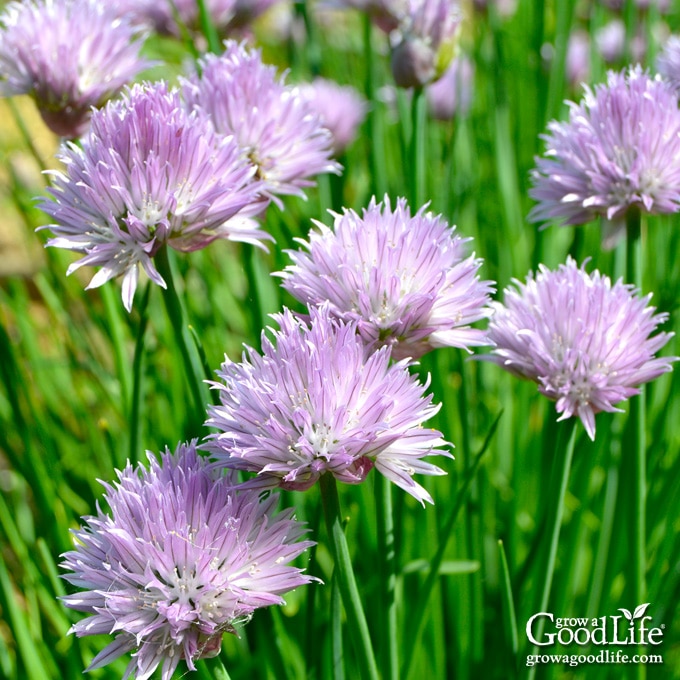
Growing chives is a great way to add a mild onion flavor and color to your dishes. You can use the spiky green foliage as a garnish or ingredient in many recipes.
Best of all, chives are easy to grow, established plants are low-maintenance, and they come back year after year. So with just a little bit of care at planting time, you can have thriving chive plants in your herb, vegetable, or container garden, and even indoors on a sunny windowsill for years to come.
About Chives
Chives are an herbaceous perennial species in the lily family (Liliaceae) and are related to onion, leeks, and garlic. Chives grow in an upright clump of hollow leaves that reach about a foot high. In summer, the plants send up pretty blossoms.
Chives are a versatile and delicious way to flavor many dishes. All parts of the plant are edible, but they are most commonly used by snipping the foliage to add color and flavor to recipes.
Chives are a perennial herb that grows back each year, sprouting from small bulbs beneath the soil. Over time, the bulbs split and form new bulbs, creating a larger clump of chives. The plant’s foliage dies back each fall, and the bulbs beneath the soil go dormant. Once warmer weather arrives in spring, the bulbs begin sending up new green spiky foliage.
You can grow chives in a circular clump or place several plants in a row to make an attractive edging to your garden. Chives even make a beautiful container plant for your porch or patio.
Why Grow Chives?
Chives are a low-maintenance herb that you can grow indoors or outdoors. They require little water and can even tolerate some neglect. Here are some benefits of including chives in your gardens:
Chives are attractive: Chives are a striking addition to flower, herb, and vegetable gardens with their spiky dark green foliage and bright lavender blossoms.
Chives are edible: All parts of the chive plant are edible. The chive’s green foliage has a mild onion flavor making them a great addition to salads, scrambled eggs, and garnish. The purple blossoms are a colorful edible decoration that adds a light onion flavor. You can even use the small bulbs in any recipe that calls for green onions or scallions.
Chives attract pollinators: The flowers bloom mid-spring to early summer, right around the same time the summer crops begin to flourish. The fragrance and color of chives attract many bees, butterflies, wasps, hornets, and other pollinators to your garden.
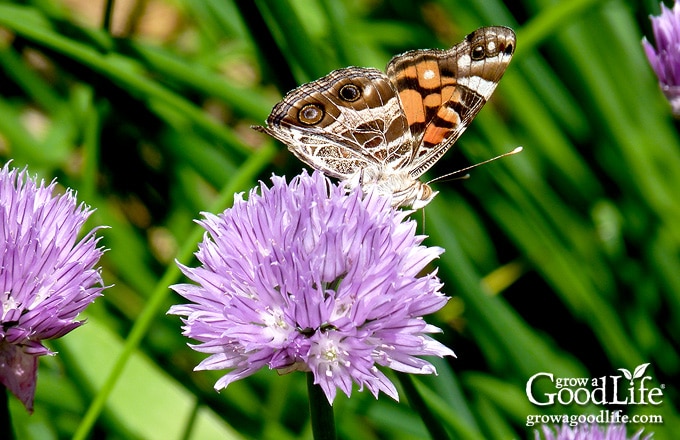
Chives repel pests: Since chives are related to onions, their pungent fragrance is a natural pest repellant. The intense smell discourages carrot flies, aphids, beetles, and cabbage worms. Plant a few clumps of chives as companion plants with carrots, tomatoes, and any crop in the cabbage family. Also, plant a few clusters around your cucumber and squash plants to repel cucumber beetles. Additionally, consider companion planting with your flowers and fruit bushes to help prevent infestations of climbing insects and deter deer and rabbits.
Chives are perennials: Chives grow as perennials in US plant hardiness zones 3 to 9. Plant chives once, and they will come back every year.
Chives self-sows easily: Leave the blossoms on the plant, and they will shake out their seeds. Then, you’ll find the spiky foliage growing come summer. Dig up these volunteer chive plants and replant them elsewhere.
Chives are easy to propagate: Chive bulbs can be easily divided from the mother plant and replanted. Plants grown from divisions are ready to harvest as soon as they are established and show new growth.
Chives are the first to sprout in spring: Chives are very cold hardy and are one of the first greens to appear in the garden in spring, a welcomed sight after a long winter.
Chives are drought tolerant: Established chive plants can handle low moisture conditions.
Types of Chives
Two popular varieties of chives are common chives and garlic chives. Their growing conditions are similar.
- Common chives (Allium schoenoprasum): Common chives, also called onion chives, have a mild onion taste. The plant features thin, hollow, dark green foliage that grows in a dense clump up to 12 inches high. Flower clusters bloom on stems that rise above the foliage in late spring through early summer.
- Garlic chives (Allium tuberosum): Additionally called Chinese chives, geisha garlic chives, Chinese leeks, and gow choy have a mild garlic flavor. The foliage is thin, flat leaves that grow in a clump up to 15 inches high. The star-shaped white flowers bloom in late summer and early fall.
Tips for Growing Chives
Chives are a great addition to your herb and vegetable garden. They can also be incorporated into your flower garden as the attractive foliage and blossoms blend well with other ornamentals. You can plant chives from seeds, transplants, or divisions.
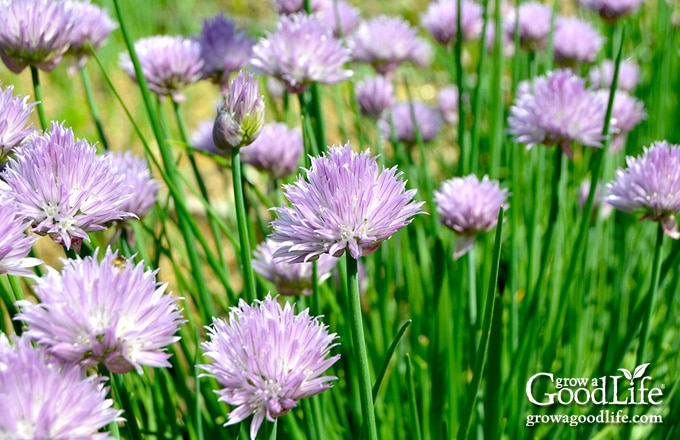
Select and Prepare Your Growing Area
Choose a permanent spot to plant your chives. Since they are cold-tolerant perennials, chives will grow back each year, and the clump will spread over time. So allow plenty of space for an easy crop year after year.
Chives grow best in full sun and rich, well-draining soil. But will also tolerate partial shade and a wide variety of soils, although they may not grow as vigorously. Select an area that receives at least 6 hours of sunlight daily.
Mix a generous amount of compost and a slow-release, all-purpose fertilizer into the soil before planting, and water the area thoroughly the day before you transplant.
How to Start Chives from Seed
Chives are easy to grow from seed. However, like most perennials, chives will take a year to produce a clump large enough for harvesting. If you don’t mind the wait, you can start seeds early under lights and transplant them into the garden in spring.
Chive seeds are only viable for a year or two. So start with fresh seeds. Direct sow seeds outside in spring as soon as the soil can be worked, or sow seeds 6 to 8 weeks before your last spring frost date (look yours up here at PlantMaps.com). Follow the steps in this article: How to Start Seeds Indoors.
It will take 10 to 20 days for the seeds to germinate. Chives grow in clumps, so there is no need for thinning.
Select and Prepare Your Growing Area
Choose a permanent spot to grow your chives. Chives grow well in full sun, but will also grow in partial shade although they may not bloom as strongly. Since they are perennial, chives come back every year, and the clump will spread slightly each time. Allow plenty of space for an easy crop year after year.
Chives are tolerant of a wide variety of soils but will grow best in rich, well-drained soil. Mix a generous amount of compost and a slow-release, all-purpose fertilizer into the soil before planting. If the weather has been dry, water the bed thoroughly the day before you transplant.
Transplanting Chives to the Garden
While established chive plants are frost-tolerant, young plants are more sensitive to cold. Therefore, transplant your seedlings into the garden after all danger of frost has passed.
Whether you grow your own chive transplants or buy plant starts from a local garden center, harden them off before planting. The hardening-off process helps your young plant adjust to outdoor conditions before planting. Check out this article to learn How to Harden Off Seedlings.
Then, select an overcast day to plant. Water your plants well to help the roots stay together and prevent damage when transplanted.
Dig a hole large enough to comfortably contain the entire root system and set the crown about 1/2-inches below the soil surface. Water the hole thoroughly, and then let the water drain.
Carefully remove the seedlings from the containers, place them into the hole, and lightly firm the soil. Water the transplanted chive seedlings well to remove air pockets. Space the plants about 8 to 12-inches apart.
Add a layer of mulch, such as straw or shredded leaves to help conserve moisture and keep the weeds down. Water frequently when the chive plants are young, and then reduce watering once the plants show signs of growth.
Caring for Your Chive Plants
Once the plants are established, chives don’t need much care, are not bothered by many pests, and are not fussy about the quality of the soil they are growing in. They continue to thrive even in drought situations. Water if the conditions are very dry and the foliage tips begin to turn brown.
After the blossoms have faded, trim the plants down to about 6-inches, and they will push out a fresh flush of spiky foliage that will provide you with plenty of harvests well into fall.
As winter approaches, the foliage will die, the plants will go dormant, and wait for the spring soil to thaw so they can emerge once again. Add a layer of finished compost around the plant each spring and a fresh layer of mulch to keep down weeds.
Divide Chives and Grow More Plants
Chive bulbs multiply over time. To keep plants healthy and from becoming overcrowded, divide plants every 3 years. You can divide established chive plants in early spring or fall.
Divide by digging up the clump, separating the bulbs into small clusters, and replanting. If dividing in fall, consider transplanting a section into a pot to grow indoors for winter. Check out this step-by-step tutorial for more detailed information: Growing Chives Indoors: How to Divide and Pot Up Chives.
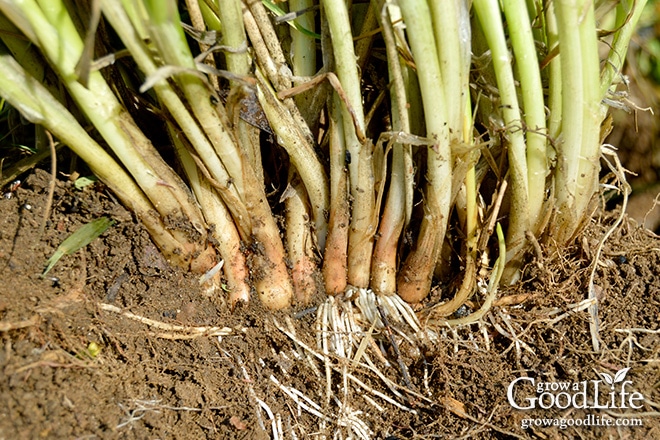
How to Harvest Chives
Harvest chives sparingly for the first year to let new plants become established. Then the plants will produce many harvests for years to come.
Harvest with scissors, cutting the leaves about 2 inches from the soil. Chop the chives and add them to scrambled eggs, salads, soups, and stir-fry. Use as a pizza topping, sprinkle on a baked potato, or scatter on a bagel with cream cheese.
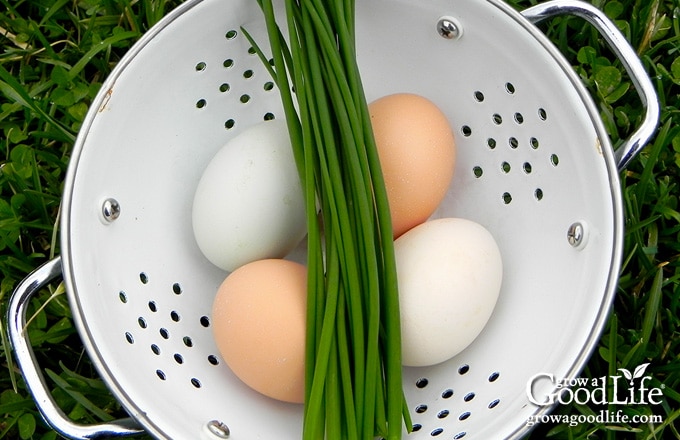
Chive blossoms are also edible and have a light onion flavor. Snip off the blossoms when they open fully. Use the blossoms as an edible garnish, add the flowers to scrambled eggs, or sprinkle them in a green salad. Infuse the chive blossoms in vinegar for a subtle onion flavor and a pretty purple blush of color.
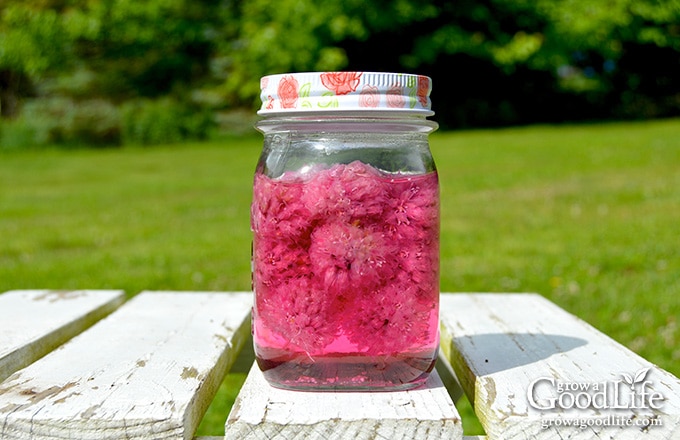
Chives require little care, thrive in many environments, and are a delicious way to add flavor to your food. Plant chives today, and these hardy perennials will reward you year after year.
Good planning is key to a successful vegetable garden
Whether you are new to growing your own food or have been growing a vegetable garden for years, you will benefit from some planning each year. You will find everything you need to organize and plan your vegetable garden in my PDF eBook, Grow a Good Life Guide to Planning Your Vegetable Garden.


I’m wondering, I have an established plant next to the house. Would you think if I separated some bulbs and transplanted them inside they would come to life? It’s mid-January here in Wisconsin and we are having a mild winter… Thank you,
Christine
Christine, Yes, your chives will come back to life indoors. I did this in November when the ground was still soft enough to dig. Cut the chives back to about 4 inches and follow the steps outlined in this article: Potting Up Chives. Look out for pests. I had a cutworm in the soil that would come out at night and munch on the foliage. It took me a while to catch him in the act with a flashlight.
Thank you so much! Will give it a try!
The photo on this page has chive with BROWN BULBS. Where can I find this RARE Brown chive?
Cassy, These are the bulbils of common chives (Allium schoenoprasum). Nothing rare about it.
As a child, chives were one of my favorite herbs in my mother’s garden. I loved the pretty flowers and used snips of it to “flavor” the “tea” for my dolls. Oddly enough, my fond memories of playing with chives is one of the biggest impacts on why I now want to grow my own garden (behind only strawberries and raspberries). I just love them and their pretty purple flowers ?
Lauren, That is such a wonderful memory. I bet you smile every time you see chive blossoms.
My mom and now I have had 3. Clumps of.chives always. Every week we chop one to about 2″ from the root. Never let it flower or you will have them everywhere! If you cut back just one.cLump evrryweek you will have greens to eat all the time.
Great tip, Megan! Thanks for sharing.